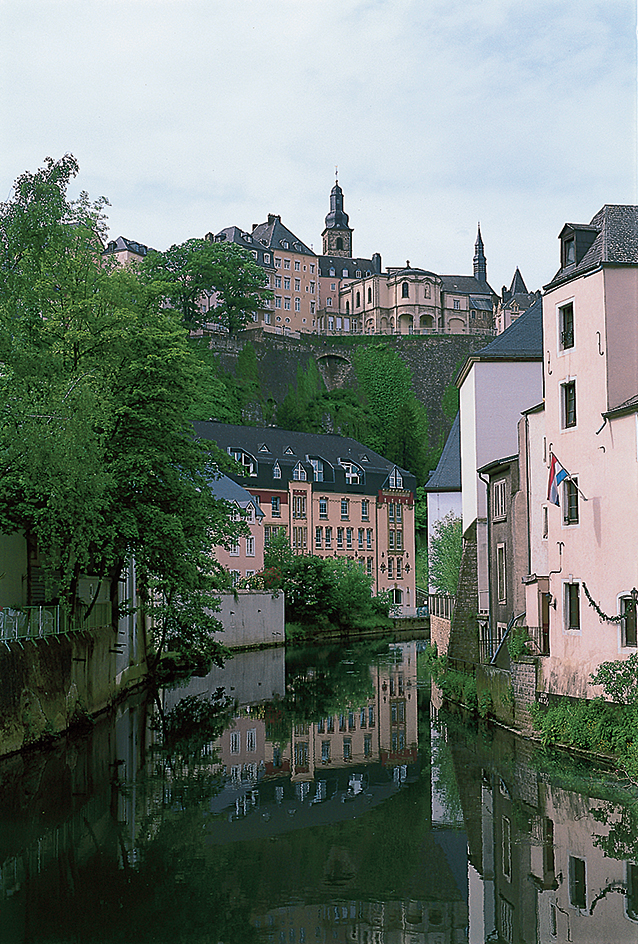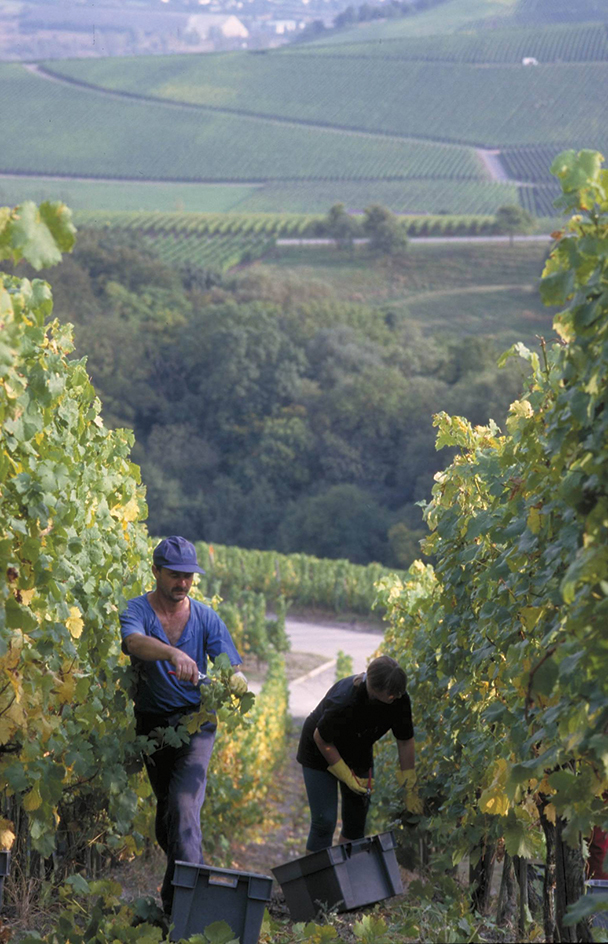Luxembourg << LUHK suhm `burg` >> is one of Europe’s oldest and smallest independent countries. It lies in northwestern Europe where Germany, France, and Belgium meet.

Luxembourg has scenic areas of rolling hills and dense forests. The whitewashed houses in towns and villages cluster around medieval castles and churches. Luxembourg is also highly industrialized. Most of its industries are in the southwest corner of the country.
Luxembourg was established as an independent state in 963. Its official name is Grand-Duche de Luxembourg in French and Grossherzogtum Luxemburg in German (Grand Duchy of Luxembourg). The city of Luxembourg is the country’s capital and largest city.
Government.
Luxembourg is a constitutional monarchy. The grand duke (or duchess) of the House of Nassau serves as monarch and the country’s chief executive. The monarchy passes to the oldest son or daughter of the monarch. A 60-member parliament called the Chamber of Deputies makes Luxembourg’s laws. The people elect the members to five-year terms.

The monarch appoints a prime minister and a Council of Ministers to carry out the operations of the government. The ministers must have the support of a majority of the members of parliament. The monarch also appoints for life a 21-member advisory body called the Council of State.
Luxembourg is divided into three districts, each headed by a commissioner appointed by the national government. The districts are divided into 12 cantons, and the cantons are divided into communes. Elected officials head the cantons and communes.
People.
Luxembourgers have close cultural ties with neighboring Belgium, France, and Germany. However, they maintain an independent spirit, as expressed in words of their national motto, “Mir welle bleiwe wat mir sin” (“We want to remain what we are”).
Loading the player...Luxembourg's national anthem
Most Luxembourgers have better food and housing than many other Europeans have. The country has extensive government social security and health care benefits. Luxembourg’s high standard of living attracts people from other parts of Europe. Nearly one-half of Luxembourg’s population are immigrants.
Pork and freshwater fish, especially trout, are favorite Luxembourg foods. Beer and wine are popular beverages. Many people live in charming villages where buildings constructed in the 1900’s stand beside those dating from the 1100’s, 1300’s, and 1700’s. The cities have many modern office and apartment buildings.
Luxembourg has three official languages: French, German, and Letzeburgesch. Letzeburgesch, a dialect (local form) of German, is a widely used everyday language. German is used in most elementary schools, and French is used in most high schools. Newspapers are printed in German. French is used in the courts and parliament. Most Luxembourgers are Roman Catholics.
The law requires children between the ages of 6 and 15 to attend school. The University of Luxembourg was founded in 2003. Almost all adult Luxembourgers can read and write.
Land.
Luxembourg has two distinct land regions, the Ardennes and the Bon Pays (Good Land). The Ardennes cover the northern third of Luxembourg, and the Bon Pays makes up the rest. The Ardennes are part of a mountain system that extends from Germany’s Rhineland into Belgium and Luxembourg. River valleys cut through the region’s low hills. Buurgplatz (1,835 feet, or 559 meters), a hill in the Ardennes, is Luxembourg’s highest point. Most of the Bon Pays is a hilly or rolling plateau with level areas along its rivers. The Attert, Alzette, Moselle, and Sure rivers flow through the region. The Bon Pays is an important farming region.

Most of Luxembourg has a cool, moist climate. The average temperature in the city of Luxembourg is about 32 °F (0 °C) in January and about 63 °F (17 °C) in July. Rainfall varies from about 40 inches (100 centimeters) a year in southwestern Luxembourg to from 12 to 16 inches (30 to 41 centimeters) a year in the southeast. Most snowfalls occur high in the Ardennes.
Economy.
Steel manufacturing has long been important to Luxembourg’s economy. ArcelorMittal, the world’s leading steel producer, is headquartered in the country. However, steel production in Luxembourg has been declining since the 1970’s. As a result, the government has worked to add variety to the economy.
Luxembourg now has a number of high technology industries, which produce such goods as computers and other electronic equipment. Many foreign companies have opened factories that make such products as chemicals, plastics, and tires. Numerous foreign banks have offices in the country. Tourists from other European countries contribute much to Luxembourg’s economy.
Agriculture plays a small role in the country’s economy. Farmers raise beef and dairy cattle, chickens, and pigs. Grapes grown on terraces along the Moselle River produce good wine. Farmers also grow barley, potatoes, rapeseed, and wheat.

Luxembourg is a member of the European Union and trades chiefly with other members. The country imports more than it exports. The country imports automobiles, food, machinery, and petroleum products. Leading exports include machinery, rubber products, and steel products.
Luxembourg has thousands of miles of paved roads. Its railroads connect eastern France with Belgium. A major international airport is just outside the capital.
History.
Luxembourg was established as an independent state in 963, when Siegfried, Count of Ardennes, gained control of the area and built a castle on the site of the present-day city of Luxembourg. In 1308, Henry VII, Count of Luxembourg, became emperor of the Holy Roman Empire. His grandson, Charles IV, created the Duchy of Luxembourg in 1354.
Philip the Good of Burgundy conquered Luxembourg in 1443. In 1684, France took control of Luxembourg. Luxembourg became part of Spain in 1697. Austria gained control of it in 1714. In 1795, Luxembourg again became part of France.
In 1815, after the defeat of Emperor Napoleon I of France, the Congress of Vienna made Luxembourg a grand duchy that was technically ruled by the Netherlands. But Luxembourg was largely self-governing. In 1890, Wilhelmina became queen of the Netherlands. Luxembourg then broke away from the Netherlands and named its own monarch, because the grand duchy’s laws did not allow a woman to rule.
In 1912, the laws were changed to allow Marie Adelaide of Nassau to become the ruling grand duchess. Her sister Charlotte succeeded her in 1919.
Germany occupied Luxembourg during parts of World War I (1914-1918) and World War II (1939-1945). In the winter of 1944 and 1945, part of the Battle of the Bulge was fought in northern Luxembourg. Thousands of Americans killed in that battle are buried in Hamm.
In 1945, Luxembourg became a member of the United Nations (UN). It joined an economic union called Benelux in 1948, and became a member of the North Atlantic Treaty Organization (NATO) in 1949.
In the 1950’s, Luxembourg helped found several European economic groups. These groups became the basis of the European Community (EC), an economic association of European nations. In 1964, Charlotte abdicated to allow her son Prince Jean to become grand duke.
In 1993, Luxembourg and the other EC countries formed the European Union (EU), which works for both economic and political cooperation among its member nations. The EC was incorporated into the European Union.
In 2000, Jean stepped down from the throne. His son Prince Henri became grand duke. The country experienced a sharp increase in population growth during the early decades of the 2000’s. Thousands of new residents came from Portugal, France, and other European countries.
Today, Luxembourg plays an important role in European matters. The city of Luxembourg is the seat of several EU agencies, including the secretariat (administrative staff) of the European Parliament and the European Court of Justice.
